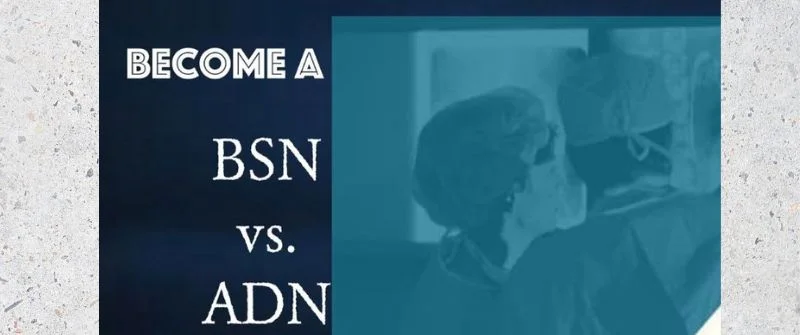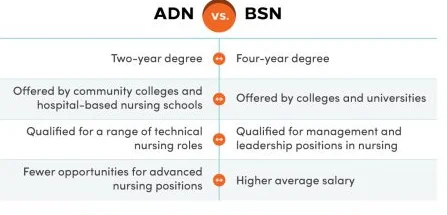Difference between ADN and BSN Nurses Essay: Intro- Conclusion

As a dynamic field, nursing requires advanced knowledge and skills that define the practice’s professionalism.
To achieve this knowledge and professionalism, the nursing practice has two levels of qualifications; an Associate’s Degree in Nursing, the ADN, and a Bachelor of Science in Nursing, the BSN (AACN, 2013).
The BSN is a nursing qualification that has a degree of four years of study. On the other hand, the ADN qualification has two years of study focusing on tasks and skills.
Despite the difference, nurses are required to have the capability of making decisions based on their education as well as their exposure to the experience of practice.
What is the difference between ADN and BSN Nursing
The first main difference between the two levels of nursing is their educational preparation. The BSN requires an educational study that allows for an extensive understanding of the economic, political, and social issues that affect health care.

The educational levels of the BSN are advanced and provide more studies to nursing students.
However, how they craft and write their nursing research and term papers is the same.
While the two-level study nursing with all its contents entirely, the BSNs possess more advanced educational knowledge than the ADNs (AACN, 2013).
This makes the BSN courses to be longer than the ADN courses.
Whether in degree or diploma programs, BSN holders have more qualifications in academic terms.
Another difference between these two levels of nursing is the skills that each is supposed to possess for proper Practice. The ADN holders have general education and skills to help them serve the general role of nursing (AACN, 2013).
However, BSN holders have proper communication and human skills to handle patients.
They are required to have excellent critical and logical thinking skills, which will enable them to make critical decisions in their practice (AACN, 2013).
In addition, BSN nurses have excellent skills in pathophysiology, health care quality control, and general community health. This makes the BSN holders good in taking care of the patients due to their application of these skills in patient care.
The role played by the holders of each of the two levels of nursing is another field of difference. Because of their advanced skills and educational competence, the BSNs hold advanced roles in the nursing practice (AACN, 2013).
The BSN carries the advanced tasks of quality patient care intended to make the patient feel satisfied and able.
They hold specific roles in caring for patients with specific issues and require specialized attention. On the other hand, the AND have nursing skills for the general care of patients.
They hold the general role of providing general nursing care to patients.
The ADN takes nursing tasks without considering the extent and significance of resources applied to the tasks. This is because the nurses at this level have limited ability to incorporate research and advanced knowledge into their practice of patient care (AACN, 2013).

Therefore, they are obliged to seek assistance to the BSNs or higher-level health workers.
This means that the ADN holders have low working independence limited to their competence and skills (AACN, 2013). This means they must seek help or accompaniment when carrying out nursing activities.
For instance, during post-operative surgery, the ADN holder may be unable to apply the patient’s history when transfusing blood. They may also need to write a nursing report from his or her observation.
This calls for assistance from a BSN who can apply advanced nursing skills to apply the past details of the patient.
The differences between the competencies of these two levels in a typical patient care case are based on the level of their skills and knowledge.
A BSN holder can understand the patient in all the circumstances and facts around the case (AACN, 2013). This means that the BSN will make critical decisions about the patient’s situation and the applicable knowledge.
Therefore, a BSN is competent in both the community and clinical settings. This diversity gives the BSN an upper hand in handling certain cases of patients despite both having licensure to practice nursing.
To explore the differences in relation to patient cases, the following case will illustrate their competencies.
Patient Case study to show how BSN and ADN will Handle him
Max is a 21-year-old patient brought by his mother, Jane, to the hospital, complaining of throat pains when swallowing food. He was booked for a 24-hour Tonsillectomy observation.
The ADN nurse who observed him saw nothing wrong, as it seemed then. Therefore, the ADN gave him painkillers and left the room.
As it was the hospital’s rules, she reported to the nurse in the evening shift, a BSN. On reading the report, the BSN quickly checked the patient and found a critical condition.
The BSN nurse knew that throat pains indicate a possibility of bleeding after a Tonsillectomy. Due to the critical nature of the situation, the BSN initiated a rapid response that saved the patient’s life.
As a rewarding career, nursing for ADN and BSN teachers learn the same nursing education, but BSN has advanced knowledge and skills. The illustration shows the differences in competence between the ADN and the BSN.
The BSN could use his advanced skills and knowledge to make critical decisions. The BSN was timely in critical thinking and reasoning that proved the supremacy incompetence and skills.
Reference
America Association of Colleges of Nursing, AACN. (2013). Fact sheet: The impact of education on nursing practice. Retrieved from, <http://www.aacn.nche.edu/media-relations/fact-sheets/nursing-workforce> July 8, 2014
If you are a nurse or aspiring nurse, watch this video to learn more on this.
[youtube v=”n2qAT7BQFwY”]Jessica Kasen is experienced in academic writing and academic assistance. She is well versed in academia and has a master’s degree in education. Kasen consults with us in helping students improve their grades. She also oversights the quality of work done by our writers.




